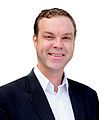The Greens NSW
The Greens NSW | |
|---|---|
 | |
| Leader | No leader |
| Founded | 1991 |
| Headquarters | 19a/1 Hordern Place, Camperdown NSW 2050 [1] |
| Membership (2019) | |
| Ideology | Green politics Progressivism Factions: Eco-socialism[3] Green liberalism[4][5] |
| Political position | Centre-left[4][6] to left-wing[7] |
| National affiliation | Australian Greens |
| Colours | Green |
| Legislative Assembly | 3 / 93 |
| Legislative Council | 4 / 42 |
| Senate | 2 / 12 (NSW seats) |
| Local government councillors | 73 / 1,480 |
| Local government mayors | 1 / 128 |
| Website | |
| greens | |
The Greens NSW, also known as the NSW Greens, is a green political party in New South Wales and a member of the Australian Greens. First formed in 1991, the Greens NSW began as a state-level party before joining with other green parties in Australia to create the current federated structure.[8]
The Greens NSW continue to be separate to the other state and territory Greens parties in several regards. The Greens NSW tend to be more left-wing in their political positions in comparison to the other state parties,[9] and continues to maintain the original Greens policy of not having a single parliamentary leader, instead being based on principles of collective leadership.[10]
The party currently sits on the crossbench in the New South Wales Parliament, and has representation federally in the Senate.
History
[edit]The first Greens party was registered in 1984, but the Greens NSW did not take its current form until 1991, when six local groups in New South Wales federated as a state political party. Greens candidates have run in every federal election since 1984, when a single candidate ran in the federal Division of Sydney.
The founding document of the Greens NSW described the organisation as the following:[11][12]
The Greens in Sydney come from many backgrounds. Environmental and resident activists. Nuclear disarmers. Dissidents from the Labor Party who have witnessed betrayals by both wings of that party. Feminists. Anarchists. Those inspired by the German Greens. Socialists of various kinds. What is distinctive and unifying about this new force in Sydney is the emphasis on encouraging people’s self-confidence in their right to have their say, their right to democratically determine matters – whether they are large or small – which affect their lives.
Local government
[edit]The party endorses candidates to stand for election in many of the 128 local government areas across NSW, including in rural and regional areas where the major parties usually do not run candidates on party tickets. The Greens NSW currently have 58 councillors on 32 local councils around NSW.[13]
In NSW, local government elections were held in September 2016 and September 2017.
In 2016 The Greens elected three mayors and 24 councillors in the 29 areas where candidates stood. Greens councillors were elected for the first time in: Albury, Broken Hill, Clarence Valley, Glen Innes Severn, Goulburn Mulwaree, Kyogle and Yass Valley. The Greens also grew their vote in Bellingen, Byron, Shoalhaven, Campbelltown, Kiama, Hawkesbury, Wingecarribee, Lismore, Hawkesbury and the Blue Mountains.
In 2017 The Greens elected a further 31 Councillors in Armidale, Bathurst, Canterbury Bankstown, Canada Bay, Hornsby, Inner West, Newcastle, Northern Beaches, Orange, Parramatta, Queanbeyan Palerang, Randwick, Ryde. Snowy Mountains. Waverley, Willoughby, Woollahra, Wollongong.
New South Wales State Elections
[edit]|
NSW Election Results |
The party first came close to electing a candidate in 1991, when Ian Cohen was the last Upper House candidate to be excluded in a contest against Christian Democratic Party leader Fred Nile for the final statewide seat. In the subsequent 1995 election, Cohen was elected to the NSW Legislative Council and became the first Greens parliamentary representative in NSW. In 1999 he was joined by Lee Rhiannon and in 2003 he was re-elected and joined by Sylvia Hale.

In 2007 Lee Rhiannon was re-elected to the Legislative Council and joined by John Kaye, bringing the number of Members of the Legislative Council to four. In 2010 Lee Rhiannon resigned from the Legislative Council to contest and win a Senate seat, and Sylvia Hale also resigned her seat. The resulting casual vacancies were filled by Cate Faehrmann and David Shoebridge respectively.
At the 2011 NSW state election the Greens further increased their vote, resulting in the election of Jamie Parker as the first Greens member of the Legislative Assembly, representing Balmain. David Shoebridge was re-elected and joined by Jan Barham and Jeremy Buckingham in the Legislative Council.
In 2013 Cate Faehrmann resigned from the Legislative Council to contest a Senate seat. The resulting casual vacancy was filled by Mehreen Faruqi of the South Sydney Greens.
At the 2015 State election current sitting members Jamie Parker, John Kaye and Mehreen Faruqi were re-elected. Two new members were elected to the Legislative Assembly: Jenny Leong in the new seat of Newtown and Tamara Smith in the previously safe National seat of Ballina. The Greens primary vote in Newtown of 45.6% is the party's highest ever primary vote in a lower house electorate. This resulted in five Legislative Council seats and three Legislative Assembly seats.
In October 2016, Jan Barham resigned and the casual vacancy was filled a few months later by former federal candidate for Richmond, Dawn Walker.
In December 2018, Jeremy Buckingham resigned from the Greens NSW.[14] Buckingham described the party as more focused on "bringing down capitalism" and "divisive identity politics" than acting on climate change.[15]
At the 2019 state election there were two upper house Greens seats up for contest as was Buckingham's. David Shoebridge was re-elected, Abigail Boyd (former federal candidate for Dobell) won one but Dawn Walker lost hers. Each of the three lower house seats were returned with a favourable swing.
Constitutional Convention
[edit]
In 1997 The Greens NSW formed part of a joint ticket called Greens, Bill of Rights, Indigenous Peoples for the 1998 Constitutional Convention held in Canberra in February 1998. Catherine Moore led the ticket and was elected for NSW. She joined Christine Milne from Tasmania to focus on ensuring that the overall process was more inclusive.[16]
Structure
[edit]
The Greens NSW retain the same basic structure which was created in 1991, with the formation of the statewide party.
State Delegates Council
[edit]The Greens NSW make decisions affecting the state party through the State Delegates Council (SDC), a meeting that consists of a delegate from each local group. The SDC is the highest decision-making body, and controls election campaigns for statewide candidatures (such as the Senate and Legislative Council). It also decides on admitting new local groups as members of the Greens NSW.
Local groups
[edit]The party is made up of 'local groups', who cover a specific geographical area. Local groups have complete responsibility for elections held in their area, particularly elections for the House of Representatives, the New South Wales Legislative Assembly or Local Government. There are currently 56 affiliated local groups in NSW.[17]
Working groups
[edit]A variety of working groups have been established by the SDC, which are directly accessible to all Greens members. Working groups perform an advisory function by developing policy, conducting issues-based campaigns, or performing other tasks assigned by the SDC. These include:
- Young Greens
- Sex, Sexuality and Gender Identity Working Group
- Women's Working Group
- Refugee Working Group
- Economics Working Group
Ideology and policies
[edit]The party has described itself as being based on the principles of: ecological sustainability, grassroots democracy, social justice, peace and non-violence.[18]
The NSW Greens want to ban new coal and gas projects, as well as ban logging in public native forests,[19] and aim for net-zero carbon emissions in NSW by 2035.[20] They want to transition towards a circular economy that eliminates waste[21] and expand the protected areas network in NSW to at least 30% of the total landmass.[22]
On economic issues, the NSW Greens want to tax big business and redirect the money towards public services.[23] The NSW Greens want to make public education free,[24] including early childhood education,[25] as well as make healthcare free and move towards more public ownership over hospitals and health clinics.[26] The party supports nationalisation of public transport and making it free to use in New South Wales.[27] The party wants to strengthen renters rights and impose rent controls,[28] as well as invest in public housing. The NSW Greens want to expand worker's rights.[29]
The party supports a legal and regulated market for the sale of cannabis.[30]
The party also supports a legal and regulated market for vaping. In this regard it supports elements such as: limits on nicotine levels in vapes, prohibiting the use of harmful chemicals in vapes, the requirement of health warnings on all vaping products, regulate vaping products so that nicotine vapes are only available to those aged over 18-years-old, to fund education programs targeted at teenagers to warn them of the dangers of vaping, and reduce the waste caused by vaping by placing requirements on producers to minimise waste and recycle used nicotine vapourisers.[31]
Political factions
[edit]There was only one publicly acknowledged faction within Greens New South Wales which is the Left Renewal faction. It was formed in late 2016 and presented itself as the far-left, anti-capitalist wing of state's party.[32][33] As of 2021, Left Renewal is not active within the party.[citation needed]
Electoral results
[edit]| Election | Legislative Assembly | Legislative Council | ||||||||
|---|---|---|---|---|---|---|---|---|---|---|
| Votes | % of votes | Seats won | +/– | Votes | % of votes | Seats won | Overall seats | +/– | ||
| 1991 | 16,556 | 0.54 | 0 / 99
|
106,325 | 3.32 | 0 / 15
|
0 / 42
|
|||
| 1995 | 87,862 | 2.57 | 0 / 99
|
126,591 | 3.75 | 1 / 21
|
1 / 42
|
|||
| 1999 | 145,019 | 3.88 | 0 / 93
|
103,463 | 2.91 | 1 / 21
|
2 / 42
|
|||
| 2003 | 315,370 | 8.25 | 0 / 93
|
320,010 | 8.60 | 2 / 21
|
3 / 42
|
|||
| 2007 | 352,805 | 8.95 | 0 / 93
|
347,548 | 9.12 | 2 / 21
|
4 / 42
|
|||
| 2011 | 427,144 | 10.28 | 1 / 93
|
453,125 | 11.12 | 3 / 21
|
5 / 42
|
|||
| 2015 | 453,031 | 10.29 | 3 / 93
|
412,660 | 9.92 | 2 / 21
|
5 / 42
|
|||
| 2019 | 435,401 | 9.57 | 3 / 93
|
432,999 | 9.73 | 2 / 21
|
4 / 42
|
|||
| 2023 | 455,960 | 9.70 | 3 / 93
|
419,346 | 9.08 | 2 / 21
|
4 / 42
|
|||
Members of Parliament
[edit]Current
[edit]Australian Parliament
[edit]-
Senator Mehreen Faruqi (2018–present)
-
Senator David Shoebridge (2022–present)
New South Wales Legislative Council
[edit]-
Cate Faehrmann (2010–2013; 2018–present)
-
Abigail Boyd (2019–present)
-
Sue Higginson (2022–present)
-
Amanda Cohn (2023–present)
New South Wales Legislative Assembly
[edit]-
Jenny Leong, Member for Newtown (2015–present)
-
Tamara Smith, Member for Ballina (2015–present)
-
Kobi Shetty, Member for Balmain (2023–present)
Former
[edit]Australian Parliament
[edit]-
Michael Organ, Member for Cunningham (2002–2004)
-
Senator Kerry Nettle, 2002–2008 (elected in 2001)
-
Senator Lee Rhiannon, 2011–2018 (elected in 2010)
New South Wales Legislative Council
[edit]-
Ian Cohen (1995–2011)
-
Lee Rhiannon (1999-2010)
-
Sylvia Hale (2003–2010)
-
John Kaye (2007–2016)
-
David Shoebridge (2010–2022)
-
Jan Barham (2011–2017)
-
Jeremy Buckingham (2011–2018)
-
Mehreen Faruqi (2013–2018)
-
Justin Field (2016–2019)[a]
-
Dawn Walker (2017–2019)
New South Wales Legislative Assembly
[edit]-
Jamie Parker, Member for Balmain (2011–2023)
See also
[edit]References
[edit]- ^ "Contact Us". Retrieved 27 August 2024.
- ^ Hannam, Peter (4 October 2020). "'Shocked': quarter of Nationals members quit since coming to power". Sydney Morning Herald. Retrieved 2 April 2021.
- ^ See Left Renewal
- ^ a b McGowan, Michael (12 December 2018). "NSW Greens on brink of 'irrevocable split', two right faction MPS warn". The Guardian.
- ^ Brull, Michael (22 February 2019). "The Incredible Wrecking Campaign Inside the Greens NSW". New Matilda.
- ^ "The Incredible Wrecking Campaign Inside the Greens NSW".
- ^ Chan, Gabrielle (22 December 2016). "Richard Di Natale says Greens group that wants end to capitalism does not represent party". The Guardian.
- ^ Sally Neighbour (2 February 2012). "Divided We Fall". Retrieved 25 January 2021.
- ^ Tom Raue (29 May 2018). "Is there a future for the left in the Greens?". Retrieved 25 January 2021.
- ^ Christine Cunningham (1 January 2014). "Leadership and the Australian Greens". Retrieved 25 January 2021.
- ^ "Eggs Over Albanese: Labor's Green Ham-Fisted Attempt To Distract On Stacking". New Matilda. 29 June 2020.
- ^ Raue, Tom. "Is there a future for the left in the Greens?". Overland literary journal.
- ^ "Greens on Council".
- ^ Josh Taylor (20 December 2018). "Jeremy Buckingham Is Quitting The "Corrupt" NSW Greens". BuzzFeed. Retrieved 25 January 2021.
- ^ Michael McGowan (20 December 2018). "NSW MP Jeremy Buckingham quits Greens and will run as an independent at election". TheGuardian.com. Retrieved 25 January 2021.
- ^ [1] Archived September 21, 2006, at the Wayback Machine
- ^ "Local Groups". greens.org.au. 6 September 2014. Retrieved 15 October 2016.
- ^ "About Greens NSW". greens.org.au/nsw. The Greens NSW. Retrieved 8 May 2023.
- ^ Parkes-Hupton, Heath (11 March 2023). "Greens eye holding balance of power as experts predict tight result in New South Wales election". ABC News. Retrieved 8 May 2023.
- ^ "Climate Change | Greens NSW". The Greens NSW. Retrieved 24 September 2023.
- ^ "Waste Elimination | Greens NSW". The Greens NSW. Retrieved 24 September 2023.
- ^ "National Parks and Other Protected Areas | Greens NSW". The Greens NSW. Retrieved 24 September 2023.
- ^ "Increasing Coal Royalties | Greens NSW". The Greens NSW. Retrieved 24 September 2023.
- ^ "Education | Greens NSW". The Greens NSW. Retrieved 24 September 2023.
- ^ "Early Childhood Education | Greens NSW". The Greens NSW. Retrieved 24 September 2023.
- ^ "Health including Mental Health | Greens NSW". The Greens NSW. Retrieved 24 September 2023.
- ^ "Public Transport". greens.org.au/nsw. The Greens NSW. Retrieved 8 May 2023.
- ^ Wang, Jessica (11 March 2023). "NSW Election 2023: Greens list demands for Labor". news.com.au. Retrieved 8 May 2023.
- ^ "Work and Industrial Relations | Greens NSW". The Greens NSW. Retrieved 24 September 2023.
- ^ "Drug Regulation and Harm Minimisation | Greens NSW". The Greens NSW. Retrieved 24 September 2023.
- ^ "Greens Propose Plan to Regulate Vaping to Reduce Harms". greens.org.au/nsw. The Greens NSW. 28 February 2023. Retrieved 8 May 2023.
- ^ "Lee Rhiannon downplays reports Left Renewal faction is splintering Greens". www.theguardian.com. The Guardian Australia. Retrieved 5 March 2019.
- ^ Aston, Heath (22 December 2016). "Hard-left faction forms inside Greens aiming to 'end capitalism'" – via The Sydney Morning Herald.
- ^ "NSW Greens MP Justin Field quits party to sit on crossbench". The Guardian. 4 April 2019. Retrieved 14 April 2019.







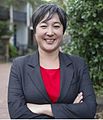
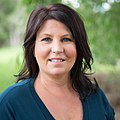







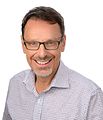


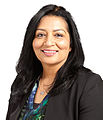
![Justin Field (2016–2019)[a]](/upwiki/wikipedia/commons/thumb/e/ed/Justin_Field_MLC.jpg/90px-Justin_Field_MLC.jpg)

